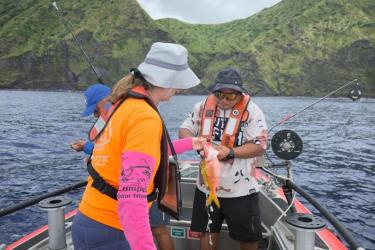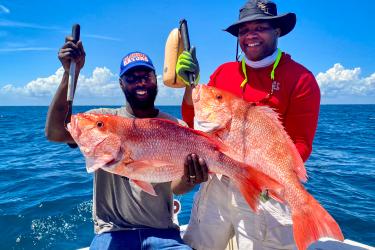One of the best things about vacation is the chance to explore new foods. Fortunately, you don’t need a travel itinerary to transport your taste buds to new locales. With these nine dishes, you can take a gastronomic tour of the United States and support regional economies all from the comfort of your kitchen.
When you’re buying ingredients, be sure to check seafood product labels or ask where a product originated. All seafood sold in the United States is required to have a country of origin label on the package. And if it’s U.S. seafood, it’s sustainable seafood!
‘Ahi Poke
Poke—pronounced poh-kay—is diced raw fish or other seafood marinated in a savory blend of sauces and seasonings. It’s a popular dish in Hawai‘i cuisine and traditionally includes minimal ingredients.
You can enjoy pokey a la carte or serve it over a bed of rice to make a poke bowl.
Baked Lingcod with Sorrel
Lingcod is not actually a species of cod, although it has the same mild flavor and flaky texture as many cod. Seafood lovers from Alaska to California serve it baked, broiled, fried, grilled, sauteed, and steamed.
This easy lingcod recipe pairs the fish with sorrel, a leafy green vegetable with a tart, citrus flavor. You could also swap the sorrel for spinach and a squeeze of lemon.
Grilled lingcod for one recipe
Cioppino
Cioppino is an Italian-American seafood stew that originated in San Francisco. It’s traditionally made from the catch of the day. In addition to fish, Dungeness crab, clams, shrimp, scallops, squid, and mussels are all common additions.
This take on cioppino is also packed with vegetables. Serve it with toasted bread for a delicious and filling meal.
Crab Cakes with Homemade Remoulade
Crab cakes are served throughout the country, but they’re particularly popular in the Mid-Atlantic and South Atlantic states. Blue crab is a favorite choice for seafood lovers there. In the Pacific Northwest and Northern California, Dungeness crab is a popular ingredient.
This crab cake recipe from the Seafood Nutrition Partnership adds tangy flare with a remoulade sauce. Serve it as an appetizer or enjoy it as your main dish.
Dover Sole Stuffed with Dungeness Crab
This recipe from Oregon Sea Grant features two West Coast favorites: Dover sole and Dungeness crab. Dungeness crab especially is a popular draw for seafood-loving tourists.
Both Dover sole and Dungeness crab have a mild, sweet flavor. Dungeness crab brings a slightly nutty flavor to this dish’s flavor profile, while Dover sole adds a meaty texture.
New England Clam Chowder
There are many regional variations of clam chowder. One of the biggest differences between them is the base. New England clam chowder has a thick creamy base, which gives it its distinct white color. It’s typically accompanied by oyster crackers.
In addition to the typical potatoes, pork, onion, and clams, this FishWatch recipe includes Old Bay Seasoning and Tabasco sauce for an added kick.
Let’s get more shellfish in the water
Shrimp and Creamy Pumpkin Grits with Braised Pork and Sweet Potato Chips
Shrimp and grits is a modern Southern staple. The origins of grits—a type of cornmeal porridge—trace back to a recipe used by the Muscogee tribe. Shrimp and grits was a common breakfast dish in the coastal communities of South Carolina and Georgia for decades before gaining wider regional and national popularity.
This twist on a classic won the 2012 People’s Choice award at the North Carolina Seafood Festival’s annual Cooking with the Chefs program.
Simple Smoked Salmon
The name of this salmon recipe says it all. Alaska Natives have been smoking salmon for generations. There are two popular preparation methods: cold smoking and hot smoking.
The first step for both is to cure the fish in a salty brine. Salmon smoked at lower temperatures will have a rich flavor and buttery texture. Hot smoked salmon will be firm with a strong smoky taste.
Learning from Alaska Sea Grant’s master smoker
Spicy Seafood Gumbo
Like many Southern dishes, this gumbo recipe blends ingredients and cooking practices from several cultures. With its combination of shrimp, oysters, crab meat, and fish, seafood gumbo is a great addition to any seafood lover's meal plan.
Gumbo is traditionally served with rice, but you could also enjoy it with sides like cornbread and hush puppies.
NOAA Fisheries arms you with the facts about what makes U.S. seafood sustainable—from the ocean or farm to your plate. Get up-to-date information on the status of harvested marine fish and farmed fish, and learn more about U.S. seafood.











